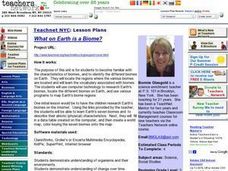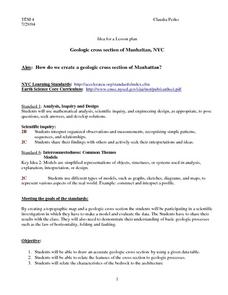Curated OER
Pesticides
Learners investigate the uses of pesticides and the pros and cons of their use. In this pesticides lesson plan, students observe simulations of the three classes of pesticides and the effects or actions each has. Learners answer 3 follow...
Curated OER
"Pressing" Issues In Zimbabwe
Students explore the nature of freedom of the press through examining a story about the capture and torture of journalists in Zimbabwe. They participate in a round-table discussion of the issues. They research an African country of their...
Curated OER
Divide Decimals by Decimals
In this dividing decimals worksheet, students review and observe examples, continue patterns, and multiply the dividend and divisor in each step by ten, so that the quotients remain the same. Students solve three problems.
NASA
Benford's Law
In this Benford's Law learning exercise, high schoolers read about the first digit frequency of numbers. Students solve 3 problems about sunspot numbers, solar wind magnetism and the depth of the latest earthquakes by using on line sites...
Curated OER
Verb Tenses and Their Uses Exercise
In this recognizing verbs in sentences activity, students review the three tenses and verb uses, fill in the blanks with uses and to complete sentences, and correct mistakes in sentences. Students write 19 answers.
Curated OER
Beginning Statistical Inquiries into the Scientific Method: Jelly-Side-Down
Students describe what happens when a piece of jellied toast is dropped off a table. From these observations, students pose a question concerning which side of the jellied toast land on the floor.
Curated OER
Walking Home II
Students explore the relationship between distance and time. They analyze a situation involving distance traveled in a given period of time, represent the situation graphically and algebraically, and discuss the concept of slope as a...
Curated OER
D¿rer Watercolor - Patterns and Texture
Students create watercolor paintings using their knowledge of elements of design, value, and texture, discuss concept of art reflecting time and place, review art-related vocabulary, and reflect on their work.
Curated OER
Writings on a River
Students identify words that can be used to describe Mark Twain's character Tom Sawyer. Students explore stage production of "The Adventures of Tom Sawyer" by reading and discussing "An Older (and Calmer) Tom Sawyer". They develop their...
Curated OER
What on Earth is a Biome?
Students explore organisms and their environments. They examine change over time
demonstrate an understanding of physical positions on Earth. They survey earth's diversity, write a report, fill in a data table created on the...
Curated OER
Periodic Properties Lab
Young scholars investigate the periodic properties of elements in the periodic table. In this periodic properties lesson plan, students experiment with elements from the Alkaline Earth Metals, the Halogens, the Transition Metals, and for...
Curated OER
Geologic cross section of Manhattan, NYC
Learners draw an accurate geologic cross section by using a given data table. They relate the features of the cross section to geologic processes. Students then relate the characteristics of the bedrock to the architecture.
Curated OER
Poetic Math Greeting Cards
Fourth graders work in groups; collect data in a survey; depict in tables, charts, or graphs the results of the survey; and make predictions. They use creative writing skills and computer skills to generate a greeting card of their own.
Curated OER
Math Snack
Students practice math skills as they sort treats for snack. They prepare a table for snack. They count snack items. They complete a graph using the counted items.
Curated OER
Being Thrifty is So Nifty
Students watch a video that focusing on budgeting while completing worksheets that include charts. They brainstorm ideas for budgeting time and money. They culminate the activity by planning an order from two different restaurants.
Curated OER
Introduction To Digital Camera
Students identify the uses of common computer peripheral devices (printer, digital camera, scanner, LCD display). They incorporate technology into a research project or unit investigation. They work on sizing pictures and putting all...
Curated OER
Cells in Series and Parallel
In this cells in series and parallel worksheet, students connect dry cells in a series and in parallel. Students chart their observations in a given table. Students answer several questions demonstrating their understanding of cells in...
Curated OER
Air Pollution:What's the Solution?-Weather's Role
In this air pollution and weather worksheet, students collect data using an online animation to determine the air quality at given times along with the wind speed and temperature in a particular city. Students make 3 bar graphs using the...
Curated OER
Exploring the Ares 1X Launch-Parameters
In this rocket launch worksheet, students solve 3 problems about the Ares 1X rocket and its launch, trajectory, and motion in both the vertical and horizontal direction.
Curated OER
Radioactive Decay and Half-Life
Students describe how the mass of a radioactive isotope changes with time and the factors that affect the rate of radioactive decay. They write nuclear decay equations to represent natural transmutation. This activity is accomplished...
Curated OER
Designing A Study
In this designing a study worksheet, students conduct a study on all types of fish that live in the Hudson River. They complete 8 various types of questions that include mostly short answer in response to their findings. Students also...
Curated OER
Deadly Lesson
Students read "Shooting at School Leaves 2 Dead and 13 Hurt" in the New York Times online. They explore their own thoughts and emotions about school violence in the wake of the March 5, 2001 school shooting in Santee, California.
Curated OER
A Whale of a Difference
Students research various perspectives on Japan's commercial whaling industry and formulate position papers representing these views. They read the Times article, Yuk! No More Stomach for Whales. Groups present their perspectives on...
Curated OER
Face The Facts To Remember
Second graders use manipulatives, drawings, and story problems to learn the two's multiplication tables. After learning how to find answers, they participate in a memory game to match facts and answers.























